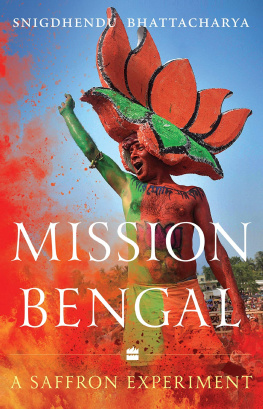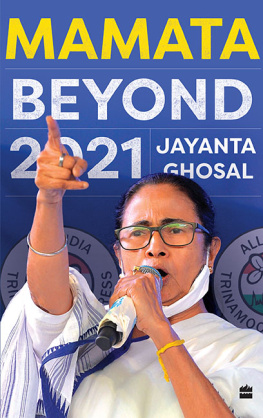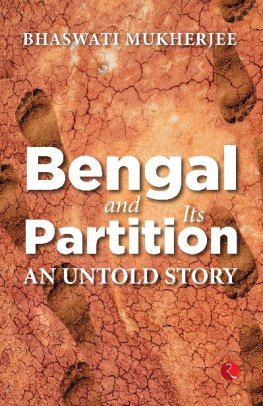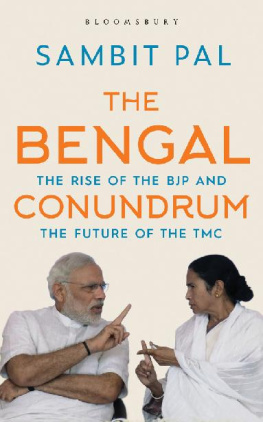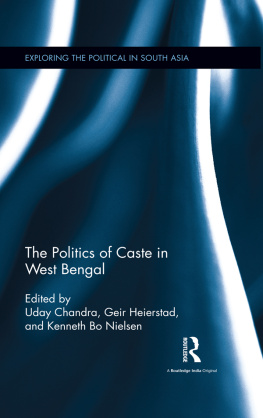MISSION
BENGAL
A SAFFRON EXPERIMENT
SNIGDHENDU
BHATTACHARYA
To Sreemanti Sengupta,
a poet, literary editor and my partner in life and crime,
without whose sacrifices this book would not have seen the light of day
Contents
THE RASHTRIYA SWAYAMSEVAK SANGHS national plan for expansion in 2009, after Mohan Bhagwat took charge as the sarsanghchalak, or the chief of the Sangh, coincided with the beginning of the decline of the Left in West Bengal. The Left Front government had, during its regime of three decades, tried its best to keep the Sangh at bay. But from 2009, with the maverick Trinamool Congress supremo Mamata Banerjee rising as an imminent threat to the regime, the Left was in no position to keep a tab on the Sanghs activities. Mamata Banerjee had started resorting to overt appeasement of the Muslims since 2008, but the Sangh Parivar was keener on seeing the fall of the Left than on training its guns on her.
In 2013, a sheer political vacuum in West Bengal with the Left and the Congress appearing to be on a path of steady decline coincided with the emergence of a pro-Bharatiya Janata Party (BJP) wave around Narendra Modi that touched almost all parts of the country. It was also the year when the RSS launched its online recruitment drive, Join RSS.
West Bengal turned into a political laboratory thereafter, with the saffron camp contrasting the atrocities against Hindus in Bangladesh with the appeasement of Muslims in West Bengal, accusing the Mamata Banerjee government of importing Islamic fundamentalism from Bangladesh, and vowing that the BJP would prevent West Bengals transformation into West Bangladesh. And Mamata Banerjee, once described as Maa Durga at an RSS event in New Delhi in 2003, had become Jihadi Didi for the saffron warriors.
For the record, Hindutva, which the RSS describes as Hindu cultural nationalism, had its roots in the undivided Bengal of the nineteenth century, in the post-Renaissance period. The coinage of Bharat Mata, the first possible use of the word Hindutva in print, the Bande Mataram slogan, the iconic image of Bharat Mata, and even the notion that Hindus were in danger of extermination all originated in Bengal and later spread to other parts of the country. Bengal, simultaneously, was also one of the key centres of Muslim separatism in India.
Ironically, despite the Sanghs first political wing, the Bharatiya Jana Sangh (BJS), being founded by a stalwart Bengali politician Syama Prasad Mookerjee BJSs ideological and organizational successor, the BJP, remained a fringe player in West Bengal until Modi arrived on the scene in 2014.
For Mamata Banerjee, the battle was not against the BJP alone; she was fighting the entire Sangh Parivar, as the RSS in Bengal had declared that the Mamata Banerjee government had become a threat to national security and that opposition to its rule was no longer a task to be left exclusively to political parties. About three dozen outfits belonging to the Sangh Parivar were active in Bengal, and nearly half of them recorded exponential expansion of activities between 2010 and 2018. The saffron camps push for Hindutva, with Jai Shree Ram as the central slogan, also triggered a revival of dormant Bengali regionalist sentiment, and Joy Bangla, a slogan used during the Bangladesh Liberation War, had a rebirth in West Bengal, post-2017. The role of the Left, its leaders and workers, added a further twist to the changing socio-political dynamic.
And then there was the mother of all controversies the one over citizenship, involving the National Register of Citizens, the Citizenship Amendment Act and National Population Register the trio of CAA-NRC-NPR, in short. It is widely believed in West Bengal that this Pandoras box on the question of citizenship was opened with the sole agenda of polarizing the state. Modi started to talk about driving out Bangladeshi Muslim infiltrators from the time of his 2014 Lok Sabha election campaign itself, and this later grew into a national issue. Even in 2019, the BJP had mentioned the NRC in their national publication on the CAA only in the Bengali edition while at the national level they maintained that the CAA was entirely unrelated to the NRC.
The Sangh Parivars battle was not easy though, as Mamata Banerjees social welfare and industrial policies, focused on micro and small-scale industries, had created a large base of beneficiaries. If the BJP dealt the TMC a rude blow in the 2019 Lok Sabha elections by increasing its tally from two in 2014 to eighteen with the TMCs numbers coming down from thirty-four in 2014 to twenty-two in 2019 the assembly bye-elections held six months later signalled that the BJP might not even be halfway through its Mission 2021. The entry of political strategist Prashant Kishor as the Trinamools advisor in June 2019 added a further twist to the narrative, with Kishor coming up with ingenious ideas to help the TMC regain lost ground.
As West Bengal stands poised for a high-voltage duel between Narendra Modi and Mamata Banerjee in the run-up to the 2021 assembly elections, this book attempts to put the battle for Bengal in its historical perspective, closely examining the workings of various RSS-affiliated organizations, the policies of Mamata Banerjee and the strategies of Prashant Kishors team, and chronicles the myriad political experiments and changing socio-political equations of this period.
The Warning
RASH MATH, BARUIPUR, 8 June 2014: Listen carefully, Sajahan Sheikh, Arabul Islam, Kaiser Ahmed, or whoever you are, we know how to retaliate. You would be shortened by six inches from the top or buried six feet beneath the earth should you try to continue with your terrorizing tactics, said the stout, mustachioed, middle-aged man speaking from the dais. He had salt-and-pepper hair and wore khadi kurta-pyjama. The dais was decked in saffron. This was twelve days after Narendra Modi was sworn in as the prime minister.
The audience, about 3,000 to 4,000 strong, cheered him with a thunderous Bharat Mata Ki Jai!
Sajahan Sheikh was a leader of the Trinamool Congress (TMC) in the Sandeshkhali area of Basirhat sub-division in North 24 Parganas district, the two others named by the speaker being TMC leaders from the neighbouring district of South 24 Parganas. Both districts had sizeable Muslim populations; South 24 Parganas was 35.57 per cent Muslim, and North 24 Parganas 25.82 per cent.
A handful of journalists, including this author, were present at the event that day. Everyone was somewhat surprised with what the man had just publicly said. That he had a special liking for this six inches or six feet phrase would be evident a couple of years later, when he would start repeating it in his public speeches. Here, his tirade continued: You have adopted the same Marxist approach of terrorizing the opponent. Do inquire from your Marxist friends in Kerala. Ask for the scorecard. If we are down by one, they [Marxists] are down by two.
The gathering erupted in applause. Bharat Mata Ki Jaaaai!
The event was organized by the Rashtriya Swayamsevak Sangh (RSS), the parent organization of the Bharatiya Janata Party (BJP), to protest the atrocities against RSS organizers perpetrated by Mamata Banerjees TMC. This was the RSSs first protest rally in Bengal in thirteen years. The last was in 2001, a public meeting to protest the killing of four swayamsevaks at Sonakhali in South 24 Parganas district, allegedly by a local Revolutionary Socialist Party (RSP) leader, who was a Muslim. At that time, the newborn TMC, which was emerging as the principal opponent of the Left Front, leaving the Congress behind, was part of the BJP-led National Democratic Alliance (NDA) government at the Centre with Atal Bihari Vajpayee as the prime minister. Now, in 2014, Mamata Banerjee was the Modi-led BJPs sworn opponent.
Next page
